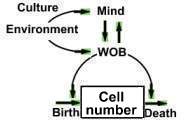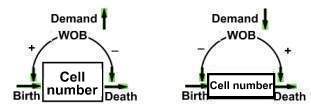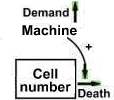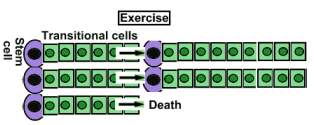
 |
First concepts
WOB is optimal
Although death is inevitable, it may be postponed by slowing down aging.
Machine aging
Aging theories are generally pessimistic. As we approach our end we can
do very little about it. This fatalistic view originates in studies on
machine aging. Wear and tear cause machines to break
down and engineers attempt
to predict its deterioration rate. Reliability theory was designed to
estimate machine survival. The longer a machine exists (survives), the
more errors it accumulates until it stops functioning. Poisson like distributions are therefore applied for modeling
machine survival.
The organism is a complex machine
Machine statistics
are applied also to estimate human survival. Actuaries calculate insurance
premiums, and epidemiologists
derive their conclusions from machine statistics. As long as these methods remain descriptive no major harm is
done . However when interfering with therapy, they may have serious consequences,
known as Iatrogenesis. Machine
statistics are applied by Evidence based
Medicine to define the normal and the pathological, and determine
what requires treatment (repair).
Now a days hardly anybody is normal, since his risk to become ill
continually increases.
Damage accumulation
No wonder that most aging theories are pessimistic. Most
regard aging as an accumulation of damage.
Medawar proposed that aging was caused
by accumulation of random mutations causing adverse aging
characteristics. The modern culprit is known as Reactive
Oxygen Species, which are forms of oxygen
that are potentially destructive to tissues. Our body carries its own
destructive molecule which is brought about by oxygen.
Hayflick limit
In 1961 Leonard Hayflick and Paul Moorhead demonstrated that human cells in culture
can only divide a limited amount of times. This phenomenon, is called
replicative senescence. Hayflick's
theory illustrates two
pitfalls. He presumed that
cells in culture had all that is needed for survival, which may not be
so. An undetectable deficiency
of a growth factor may let cells divide only a limited amount of times. After all most
cancer cells can divide in vitro for ever.
The
second pitfall is known here as context
fallacy,
A phenomenon discovered
in a narrow context (petri dish) is applied as such to the wider context of the organism. Certain cell lines such
as hemopoietic cells, bone marrow,
epithelial cells in
the skin and gastrointestinal mucosa, endure many more population doublings
in vivo than they do in vitro. Hayflick limit is a laboratory artifact
which does not apply to the organism.
Telomeres are
the latest incarnation of 'replicative senescense'. They are the tips
of chromosomes and get shorter at each division. Short telomeres cause
growth arrest and the cell dies.
True, death is inevitable, yet aging may be pleasant. Our aim here
is to slow down aging an postpone death.
A simple model
What we perceive as aging is
defined here as disease
indicator (DI), and we are concerned here with what drives it?
In order to simplify the forthcoming arguments we shall assume that aging
is driven by a gradual loss of cells due to ionizing radiation
from outer space, rocks, and the soil. Ionizing radiation produces several
changes that are comparable to those observed during normal aging. It
decreases life expectancy. After radiation of a young population, the
observed death rate corresponds to the death rate of an older group. Following
radiation, there is a reduction in the number of viable cells in many
tissues.
 |
 |
The cell number in a tissue depends on the birth and death rates of its
cells which is controlled by WOB. When the demand rises WOB increases
birth rate (+), reduces death rate (-) and the cell number increases,
and vice versa. WOB may be instructed by the mind to produce more cells,
like during exercise. When we (the mind) decide to join a fitness club,
we raise the demand on our muscles. WOB raises the birth rate and muscle
mass increases. In other words our will can force WOB to produce more
cells. The relationship between the mind and WOB is summarized by "Use
it or lose it". If the mind decides to "use it" we may
slow down aging. Yet as
The following image illustrates
that a machine does not generate new components (no birth rate). From
the time of its production its parts gradually deteriorate and die. It
can not slow down its aging. In
order to improve machine reliability it may be provided with extra parts
which later replace the damaged ones. Such a redundancy prolongs machine survival.
 |
Apoptosis or programmed
death
The cell
contents of the body depends on cell birth and death rates
. When demand for cells is high, birth rate rises, death rate declines, and cell number
rises, and vice versa. Cell production and destruction are controlled
by WOB and so is aging. Since
organism maintains homeorhesis (homeostasis)
each dead cell is replaced with a new one, and birth rate = death
rate. Aging proceeds from one
homeorhesis state to another. We ought to distinguish between two causes
of cell death: 1. Independent, driven by radiation, and 2. WOB controlled death, or apoptosis. WOB can reduce death rate and thus prolong cell survival.
 |
Solution
WOB controls all processes
and adjusts them to meet the demand of the organism, constrained by environment
and mind. When it gets cold WOB turns the heat on, and vice versa.
WOB responds also to the mind, which receives signals and directives
from society (culture). The adjustment of processes at any instant
is called WOB solution. It is always the most optimal solution in circumstances.
Aging proceeds in an optimal
fashion
This optimality principle underlies also the evolution
of aging. At any instance
WOB adjusts processes so as to make the organism optimal. What may appear to the observer as a change to
the worse is an evolution of optimal solutions. It is
plausible that radiation causes aging however other factors also contribute
to it, yet only WOB
knows what really drives aging and adjusts its solutions accordingly.
We may therefore ignore what drives aging, and focus on WOB solutions. Replacement of lost cells is
the only drive for cell birth.
Aging is an ongoing cell depletion.
It proceeds through three phases:
1. Full compensation: Linear decline of performance (linear aging). Patient feels
healthy.
2. Decompensation, Gradual
deepening of ischemia. Accelerated decline of performance. Patient suffers from secondary manifestations due to ischemia (accelerated
aging).
3. Total decompensation, or excessive cell loss (pancytopenia) and weakness.
Anti aging
From birth to adulthood organism grows, accumulates cells,
and cell birth rate > death rate. Tissues
are made of units, each nourished
by a long-lived stem cell
which breeds short-lived transitional cells. During
growth tissues get new units, and since each is nourished by a stem cell,
the number of stem cells
in the body increases. Despite being exposed to radiation
the cell content of the growing body rises. Cell birth rate exceeds death rate. Since
aging is regarded here as an ongoing cell loss, aging actually starts
at adulthood, and growth has an anti aging effect.
 |
 |
Anti aging reserve (stem
cell redundancy)
The more stem cells (units)
a young adult gets the better is he equipped for aging. Like machines which survive longer with redundant
parts. Malnutrition, infections, and other diseases, retard growth, and the adult comes up with
a smaller stem cell pool.
Full compensation
When radiation kills transitional cells they are swiftly regenerated
by their parent stem cells. However death of stem cells results in
the loss of tissue units (atrophy)
which regenerate extremely slowly. In other words, when a
tissue unit is hit, and radiation kills only transitional cells, the unit
regenerates (per primam). When stem cells die, the entire unit is lost
(atrophy). Stem cells are undifferentiated and resist radiation
better than transitional cells. Aging thus results from stem cell loss.
Decline of 'physiological'
functions
From the age of twenty and
on, WOB adjusts processes so as to make up for the loss of tissue units.
It sends the mind the message: "Take it easy and do not rush!",
and all the so called physiological functions, e.g.,
breathing capacity, muscular mass, bone density, hormonal activity,
decline linearly. When activity declines more than WOB requires,
it dismantles also inactive units, as it does to astronauts
in space. We may distinguish between two kinds of cell loss:1. Stem cell depletion (hypoplasia), caused by radiation,
and 2. Transitional cell depletion (unit hypotrophy) which results from
disuse. While unit loss is generally irreversible, unit hypotrophy is
not. It can be reversed by forceful activity.
 |
Decompensation starts when blood supply to tissues declines.
Capillaries are very sensitive to radiation.
When endothelial cells are killed,
capillaries get clogged,
and blood supply to tissues declines. Capillaries supply also blood to
the walls of blood vessels, like arteries and veins (vasa vasorum). When
they clog blood vessels become arteriosclerotic. Deepening ischemia destroys
entire tissue units, and depletes stem and transitional cells. The so
called age related diseases, e.g.,
myocardial and cerebral infarctions (heart attack and stroke), senile
cataract, senile dementia, osteoporosis , and arthritis, are the outcome
of ischemia.
During compensation WOB
task is to maintain adequate
function in spite of deepening pancytopenia.
During decompensation WOB has to handle also the ensuing diseases,
as described in the chapters on diabetes mellitus,
and Parkinson's disease
Even when most functions decline and it appears as
if the body deteriorates, WOB solutions are the best in the circumstances.
Physician's role
During compensation phase WOB is silent and patient
feels healthy; she starts
suffering when decompensation ensues. The physician's
role is to slow down the decline of physiological functions (linear aging),
and so delay the onset of decompensation (accelerated aging). WOB solves the immediate requirements of the organism
and is not concerned with
what happens next. Its attitude might be summarized by "carpe diem"
(reap now). The future ought
to concern the physician, and the future means to maintain adequate
activity.
Exercise
The next image depicts how exercise keeps us fit. When a tissue unit dies, the neighboring units elongate (hypertrophy) and perform its tasks. This process is driven by activity. When experiencing tissue damage WOB signals the mind fatigue, as if saying:"take it easy, I lost some resources and cannot assist you as before." If mind yields to WOB urge, tissue units will shrink. On the other hand if mind decides to exercise they enlarge.
 |
Mind aging
Aging is also a disease of
the mind. Mind receives signals from society and conveys them to WOB.
Yesterday it retired from work and feels rejected. It sends WOB a message
like: "why bother? "and WOB starts dismantling units like in
astronaut disease. Mind aging accelerates
linear aging and drives the
patient into decompensation. Meditation
is an effective way to reduce mind aging.
Hormone replacement therapy
(HRT)
Medicine spreads the myth that
hormone treatment slows down aging, while the opposite is true. The chapter
on Parkinson's disease
illustrates why. During
menopause, WOB reduces estrogen
production since this is best
for the organism. Most of the hormone is produced by the adrenal. When
external estrogen is supplied estrogen level rises above an optimal level,
and WOB dismantles estrogen producing units, until the optimal estrogen level has been restored.
Cell birth rate declines and death rate rises. Since cell death rate rises, aging is
accelerated.
Testosterone
Anabolic
steroids are synthetic substances related to male sex hormones (androgens). They promote the growth of skeletal
muscle (anabolic effects) and the development of male sexual characteristics
(androgenic effects). They control muscle metabolism , and have some grave side effects. Like estrogen, they impede production of internal testosterone.
Since muscles require testosterone, one may raise its level by training. Exercise raises testosterone production
in a natural way. One wonders what might raise estrogen production?
Since muscle building does not raise estrogen, what else might
raise it?
 |
Raising the level of sex
hormones slows down linear aging
Which may be achieved by sexual activity.
Active interest in the opposite gender also activates sexual processes.
Like watching the breasts of an attractive female, and imagining them
being caressed and so on.
WOB in old age
Medicine regards the aged organism
as decayed and helpless. Actually as
one gets older WOB becomes more experienced, and wiser. An elderly
does not get childhood disease, since his WOB knows how to handle invading
bugs. Some changes in the appearance of old people reflect a more optimal
design which is more pronounced
during linear aging,
and less during decompensation. Any decompensation is still the most optimal
WOB solution in circumstances.
Even cancer is handled better in old age. This may come as a surprise
since in old age cancer is more prevalent. Tumor
formation is a response to stem cell depletion, and since aging is
an ongoing pancytopenia, tumor incidence rises. However in old age tumors
grow slower than in young. Medicine
attributes it to the decaying organism which lacks resources to adequately
nourish tumors. Actually tumor grows slower since WOB
learned how to control it better. Every elderly carries the secret
of a Cancer-Yogi.
Age limit
Outside the organism stem cells may proliferate rapidly,
and for ever, and in the body this capacity is lost. In the
body each cell is innervated. Besides serving as action potential
carriers, nerves control target cell metabolism, which is known as trophic
effect . A denervated
stem cell dies. Like in peripheral diabetic neuropathy, which deprives
cells from the trophic control.
Leg tissues become atrophic, and the outcome is an ulcer.
Radiation kills also nerve cells, which regenerate
extremely slowly. When a stem cell
is killed, the availability of innervation will determine the rate of
stem cell replacement (birth rate).
The ultimate rate of aging is set by the CNS, and since it is particularly
sensitive to ischemia, brain aging accelerates decompensation.
Life is action, and adequate activity slows down aging. WOB is not concerned with slowing down aging. It aims to maintain life at minimal cost (optimality). WOB will oppose any unnecessary activity, and has to be forced by the mind to do so. Which is the essence of free will.